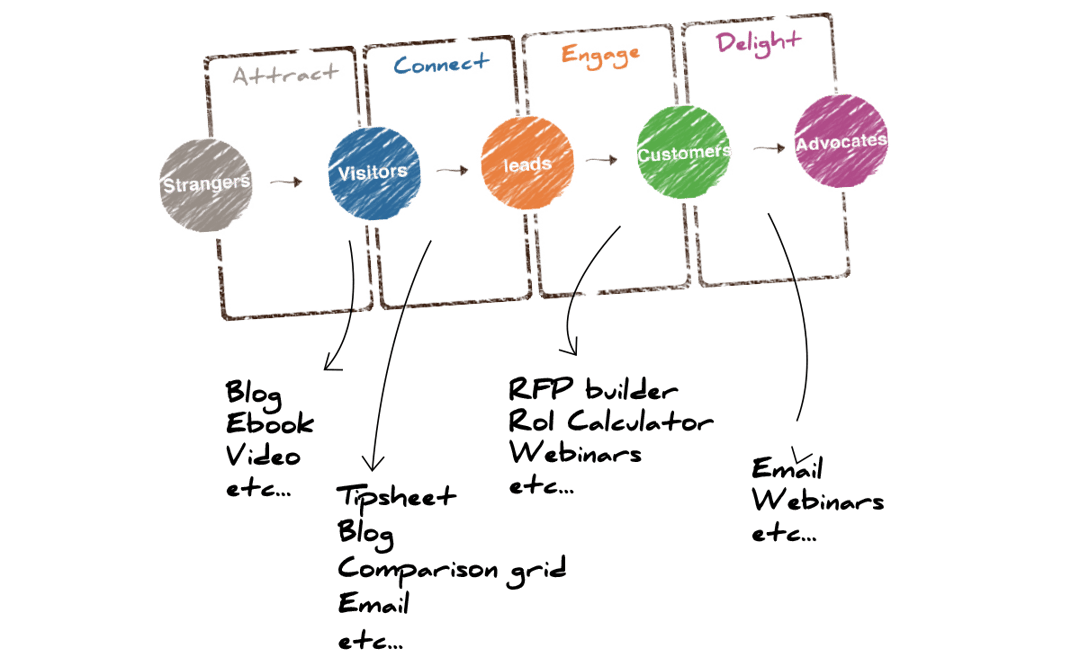Once upon a time, in the not too distant past, B2B inbound marketing didn’t exist. B2B marketing communications instead consisted of print ads, radio spots, buying email lists and cold calling.
As a B2B marketing methodology, inbound has been adopted widely by organisations who see the value of generating and quantifying good quality leads for their sales teams. Digital marketers cast off with hooks in their content that (hopefully) will attract a nibble from their target personas.
But it doesn't always work as well as hoped for some. We explore why below...
Businesses now spend time writing search engine optimised blogs, producing eBooks with key industry takeaways, and hosting webinars and podcasts. They run targeted campaigns across social media, tracking click throughs and conversion rates, and qualify leads with further research.
But let’s get something out of the way quite quickly: no one said B2B inbound marketing was going to be easy.
Doing it well requires time, effort and planning. It requires a strategic management plan and c-suite buy-in.
The rise and rise of B2B inbound marketing
Since 2005, when the phrase ‘Inbound’ was first coined by HubSpot’s Brian Halligan, B2B inbound marketing has become a burgeoning field of experimentation, innovation and evolving best practices. It has moved businesses away from the traditional blanket approach, encouraging them instead to focus on creating value for customers.
Every business wants to demonstrate the value of their services while showcasing their knowledge to clients and prospective customers. Inbound is a way of doing that. It focuses on nurturing leads through the sales funnel by delivering content relevant to particular stages in the purchasing process.
However, underestimating the difficulty of doing inbound has led to accusations about its effectiveness as a B2B marketing methodology.
Companies and digital agencies are experiencing different levels of success with B2B inbound marketing - those not seeing the results they had hoped for are left wondering what they’re doing wrong. However, the fact that many others are doing inbound to good effect means that it can also work for your business.
Squaredot have identified two high-level reasons why those who have put their eggs in the inbound marketing basket haven’t yet hatched any chicks.
- Their B2B inbound marketing methodology isn’t working.
- They’re ill equipped to compete in highly saturated B2B content sector
Since we’re not the type to give you problems without offering solutions, let’s discuss how you can address both these challenges.
What a good B2B inbound methodology looks like
This really is Business Management 101, but setting SMART goals for your B2B inbound marketing efforts is every bit as important as setting SMART business goals. Here’s a reminder:
- Specific
- Measurable
- Achievable
- Realistic
- Timely (& trackable)
Conveniently, the pain and doubt of setting, tracking and measuring SMART goals is made easy on HubSpot. They have come up with suggestions of the metrics you should be focussing on, depending on where you are in the inbound learning-and-doing curve:
- You’re just getting started with a new website, or you want more website traffic > Focus on visits
- Your website traffic is good, but you want to convert more of those hits to leads > Focus on contacts
- If you're getting a healthy amount of traffic to your content and visitors are converting on forms > Focus on customers
(Source: Hubspot )
Depending on what your focus will be, your course of action will be slightly different - more on that later. Let’s finish setting those SMART goals.
If you’ve been using HubSpot for a while, the system can use numbers from previous months as a reference point - ensuring that your goals are realistic and achievable. Before setting goals, you’ll have to ask some tough questions like: is it possible to expect 100 new leads in December when there have only been 25 in November? Our advice at this point would be to set an attainable metric of measurement - at least until your hone your B2B inbound marketing skills.

Putting the ‘content’ into B2B inbound marketing
So, you’ve set some SMART goals and decided you need to intensify your focus on contacts, for example. Next you’ll need to think about the type of content that you can produce to add value to your customers - positioning you as an authoritative industry voice into the bargain.
If your focus is on developing contacts, you’d do well to orientate yourself in the ‘connect’ phase of the sales funnel interface with customers. Here you’ll need to produce content that grabs the attention of the web visitor. Examples of highly visually and easily processed content that deliver key learning or insight could include (but isn’t limited to) tip sheets, blogs, and comparison grids.

Great! After all this working out, you now will have an idea about what you’re trying to achieve with your content and even an idea of what that content should be. But what about the content of the content? How do you know what to talk about?
Luckily, there’s a framework for that.
Where’s your content sweetspot?
The framework that we at Squaredot have devised is based on work by George Tovstiga, management educator, author and consultant, and tutor at the esteemed Henley Business School at the University of Reading.
The shaded area in the overlapping Venn diagram below is what we call the ‘Content Sweetspot’ - the area of the internet where customers are looking for expertise that you have that is different from the competition. This is where you need to cast your content net and go fishing for leads.

After you’ve extensively research every nook and cranny of your Content Sweetspot, you’ll have a better understanding of:
- Your organisation’s competitive environment
- Your organisation’s key differentiators from the competition
- An understanding of your customers and their needs
- The conditions and boundaries that define your organisation’s unique competitive arena
But your work has only really just begun. By now you’ve probably realised that there’s more to developing a good B2B inbound methodology than meets the eye. Adding up the time demands and debating whether you can deliver all of this inbound is an important conversation that every business needs to have.
Still determined to go it alone? Then you'll also need to get under the skin of your targets.
You need to do extensive persona research and work up some profiles that encapsulate their pain points. Begin by asking the type of questions they might be googling in a good old fashioned brainstorming session. Essentially you want to end your research with a list of things your target buyers want to know about. Another good place to start persona research is your own client base. You won them over, so take in the learnings
There’s little point in pulling together a content schedule if you haven’t done any keyword research. There’s a lot of noise out there, so finding an angle where you can stand out from the competition is crucial to B2B inbound marketing success.
Results from surveying the conditions and boundaries that defining your organisation’s unique competitive arena come in handy when conducting the keyword research that will underpin your content schedule. For example, what makes your product stand out? What is the uniqueness of product mix or service offering? Is price an important factor - economy or premium? Is it customisable? Niche and specific targeting will ensure that you attract the most relevant prospective customers to your content.
Aim to be informative, engaging and insightful - after all, B2B inbound marketing is all about adding value.
Factor in your outreach strategy, as the content you create should not only appeal to your target personas, but it also needs to fit in with the native content on the publications you plan to reach out to and the influencers you plan to earn backlinks from (more on that later).
The nuts and bolts of B2B inbound marketing
Content creation is just one part of the B2B inbound marketing machine - but it is the vehicle through which value is delivered to customers. Getting the tone and the visual aesthetics right will give your inbound efforts the best chance of success.
You need to assess whether you have the inhouse creative flair and capability to pull off your content creation. Do you have talented designers, copywriters, video production, editorial staff, social media curators and community managers? If not, you could hire freelancers or call up a specialist inbound marketing agency - the virtues of which we have touched on elsewhere.
Supported by marketing automation tools like HubSpot, some businesses are happy to bring their inbound efforts in-house. However, jostling operational demands with inbound marketing can result in the latter dropping down the priorities list. Results-focussed businesses frequently opt for help from a HubSpot approved digital marketing agency.
Your agency will do the research, plan, strategise, produce the content, as well as publishing and promoting it. They will also follow through with full campaign management, performance analysis, tracking and reporting.
Evaluating the success of your b2b inbound marketing efforts
As we’ve discussed earlier, and elsewhere, content marketing return on investment (ROI) can be optimised when you have clear targets and goals in mind. Choosing the right metrics to judge your success is key.
There are four common metrics used to track and evaluate the success of your content:
- Consumption metrics: how many people are seeing, or consuming, your content?
- Sharing metrics: These are the ways that your audience engages through sharing your content i.e. retweets, Facebook likes, emailing it to friends or posting it on their LinkedIn feed.
- Lead metrics: Positive results in lead generation means that your content is working toward your business objectives. The question is how to get more of this calibre of engagement.
- Sales metrics: All other metrics add up to this point. Your sales results will speak for themselves.
While getting lots of likes on a Facebook post might be instantly gratifying, they don’t say enough about how the content is helping achieve business goals. Businesses intent on converting social activity or web visits to customers choose to focus on the lead and sales metrics to evaluate the ROI of their B2B inbound marketing efforts.
The highly-saturated B2B content playing field
We mentioned earlier that we had identified two problems around why B2B inbound marketing isn’t working for your business. Remember this?
“Squaredot have identified two high-level reasons why those who have put their eggs in the inbound marketing basket haven’t yet hatched any chicks."
- Their B2B inbound marketing methodology isn’t working
- They’re ill equipped to compete in highly saturated content sector
The second reason relates to the law of supply and demand - where there is more B2B marketing content being produced than will ever be consumed. If you haven’t spent time identifying your unique competitive arena - specifics about your product or service offering and its differentiators - you aren’t in a position to attract the most relevant prospects your content.
While specificity is important to B2B inbound marketing, you also need to ensure that there’s an audience out there for what you’re writing about. Refresh yourself on the importance of keyword research before sitting down to tap out your first blog.
Cold, hard cash & other ways to get results with B2B inbound marketing
So far we’ve discussed leveraging search engines and organic social media to produce B2B inbound marketing results. Admittedly, it’s a long-winded approach - but it’s worth it for the warm flush of satisfaction you’ll feel when you hit your first target.
However, you might not be seeing the results you’d like if you’re caught up doing B2B inbound marketing in a highly-saturated content playing field. The time frame for gaining domain authority for your content is shortened when there is little or no content surplus in that industry. Unfortunately it has been argued that most industries have already reached a plateau in terms of content creation. Already you might be struggling with the feeling that everything you want to say has been said before, many times, many ways. Here's some context:
- Almost 5 billion videos are watched on Youtube every single day.
- People share 1.3 million pieces of content on Facebook every minute of every day
- 1 million professionals have published a post on LinkedIn
- 6000 tweets sent per second in 2016
IBM predicted that the ‘internet of things’ will lead to the doubling of knowledge every 11 hours - with content being the force driving this incredible change. While this is good news for mankind generally, it does make the content marketer's job a little more complex (that prediction was back in 2010; if anything they underestimated it!).
With all this ‘stuff’ out there, how can you ensure your ‘stuff’ gets seen by the right people? This challenge is a direct consequence of the content deluge.
The amount of time, energy, effort and budget required to gain the visibility in the content deluge has increased. Marketers now need to be cleverer when promoting their B2B content marketing and devising their outreach strategy - and they must use earned and paid media, too.
If you’re not quite ready to delve into the world of paid search, pay-per-click (PPC), guest blogging on high-value domain publications, native advertorial content, (not forgetting that paid ads are still viewed with a certain amount of suspicion) establishing backlinks from authoritative websites is a proven way to catapult your website up the Google ranks.
Conclusion
Businesses are sometimes surprised to learn that B2B inbound marketing isn’t a silver bullet to declining lead generation and flagging sales woes. Even with the perfect B2B marketing methodology, it isn't always immediately gratifying. Building up a rapport and engaging prospective customers - as well as retaining current customers - is an important part of the process, and that takes time.
Ultimately, HubSpot and other marketing automation tools are precisely that - tools. They still require human creativity and strategic application to work to best advantage. If you automate a weak B2B marketing methodology, you’ll never get the returns you want. If you’re disappointed with what you’ve seen of inbound so far, sit back and take stock of the situation - there’s almost always a way to turn things around, so don’t dump your content marketing strategy just yet.
While B2B content marketing isn’t a quick fix solution to larger strategic problems, it is worth dedicating the resources to doing right.
Squaredot is a Gold Tier Certified Hubspot Partner Dublin Agency - we write the content and crunch the numbers so you don’t have to. Download our handy workbook (see below) filled with industry insights, tips and help on getting the most out of Hubspot.









